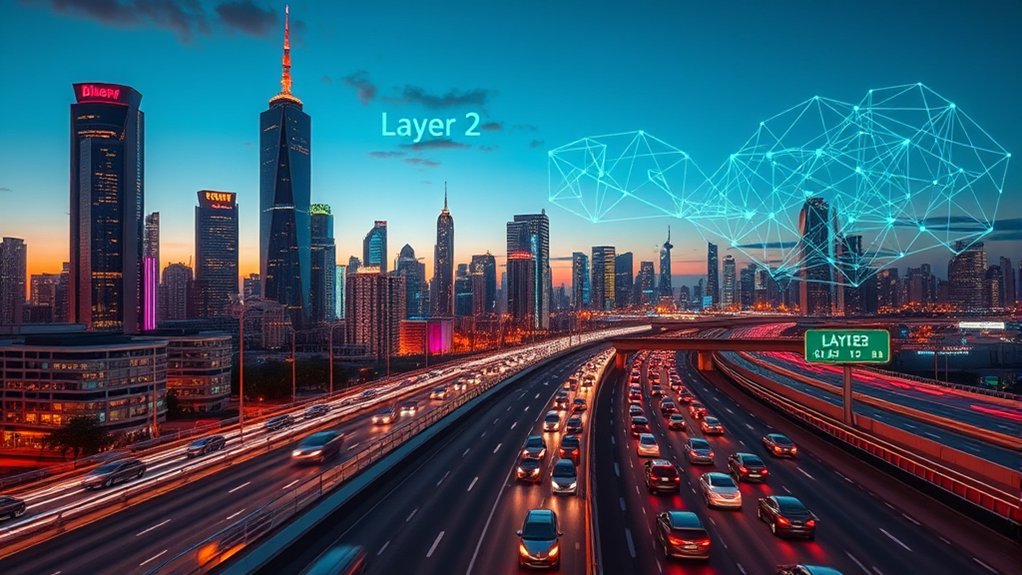Layer 2 networks in blockchain are like the fast lane on a congested highway. They solve the issue of slow transactions and high fees on Layer 1 networks. By processing transactions off-chain, they can handle way more traffic without breaking a sweat. Think of them as superheroes, ensuring security while speeding things up. Sure, they come with their own set of challenges, but their role is key to keeping the crypto world from crashing. Curious? There’s more to it.

Layer 2 networks in blockchain are, quite frankly, the superheroes of the crypto world. They swoop in to save the day when the main blockchain networks, or Layer 1, are drowning in a sea of transactions. These Layer 2 solutions are like the sidekicks you didn’t know you needed. They tackle scalability issues head-on, allowing for faster transactions and lower costs. Who doesn’t want more bang for their buck?
Layer 2 networks are the unsung heroes of crypto, boosting speed and slashing costs when Layer 1 is overwhelmed.
So, how do they pull this off? By processing transactions off-chain or in parallel, these networks reduce the load on the main chain. Think of them as a fast lane on a busy highway. They can handle way more transactions per second, making congestion a thing of the past. And guess what? They don’t compromise on security because they inherit it from the Layer 1 blockchain. Talk about a win-win! Over $30 billion is locked in Layer 2 solutions in the Ethereum ecosystem, showcasing their growing importance. Additionally, Layer 2 networks provide higher transaction throughput than Layer 1, which significantly enhances user experience. This is exemplified by solutions like Polygon’s PoS blockchain, which effectively boosts Ethereum’s scalability.
There are various types of Layer 2 solutions, each with its own flavor. Optimistic rollups are like the laid-back buddies of the group, using fault proofs to verify transactions. Then you’ve got zero-knowledge rollups, which are more about privacy and security—definitely the overachievers in the crowd. Sidechains and validiums provide flexible scalability options, while state channels are the quick-decision-makers, processing transactions outside before finalizing them on-chain. It’s a whole ecosystem of efficiency.
However, it’s not all rainbows and butterflies. Layer 2 solutions can be technically complex, and they rely heavily on the security of the underlying blockchain. If that chain falters, so does the whole operation.
Plus, they face interoperability challenges when trying to work across different Layer 1 networks. It’s like trying to get a cat and a dog to play nice—good luck with that.
In the end, Layer 2 networks are critical for the future of blockchain. They promise enhanced scalability, reduced costs, and increased adoption. Without them, the crypto world might just collapse under its own weight.
Frequently Asked Questions
How Do Layer 2 Networks Improve Transaction Speed?
Layer 2 networks are like a turbocharger for transaction speed. They handle transactions off-chain, meaning the main blockchain doesn’t get bogged down.
Think of it as taking the express lane while everyone else is stuck in traffic. With methods like rollups and state channels, they can process tons of transactions fast, often way faster than the sluggish Layer 1.
It’s all about speed, efficiency, and keeping those pesky fees low. Who doesn’t want that?
What Are the Main Types of Layer 2 Solutions?
Layer 2 solutions are basically the superheroes of the blockchain world. They come in several varieties.
First up, state channels—off-chain transactions that save everyone on fees.
Then there are sidechains, which like to play on their own turf.
Rollups? Oh, they’re the cool kids combining transactions to speed things up.
Optimistic and ZK Rollups are in the mix too, each with their own style.
Are Layer 2 Networks Compatible With All Blockchains?
Layer 2 networks aren’t a one-size-fits-all deal.
Sure, they shine on Ethereum, but can they just waltz into other blockchains? Not really. Each blockchain has its quirks, like a stubborn teenager. Compatibility issues pop up, making integration tricky. Some might even throw a tantrum.
Sure, there’s potential, but it’s not a cakewalk. So, while it’s possible, don’t expect smooth sailing everywhere. Just another day in the wild world of blockchain.
How Do Fees Compare Between Layer 1 and Layer 2?
When comparing fees, Layer 1 networks are like that overpriced restaurant everyone talks about—high demand, high costs, and a long wait.
Layer 2, on the other hand, is the food truck down the street: cheap eats and quicker service.
Layer 1 fees skyrocket during congestion, while Layer 2 solutions keep costs low by processing off-chain.
What Security Risks Are Associated With Layer 2 Networks?
Layer 2 networks come with their fair share of security headaches.
Cross-chain bridges? A playground for hackers.
Centralization? Yeah, it’s like inviting a wolf to guard the sheep.
Data management? Good luck with that—if it’s gone, disputes will fly.
And smart contracts? They can be a ticking time bomb if not audited properly.
Basically, it’s a wild west out there, and the risks are as real as they come.
Buckle up!





